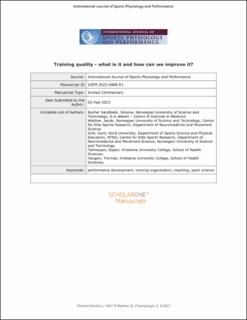| dc.contributor.author | Sandbakk, Silvana Bucher | |
| dc.contributor.author | Walther, Jacob | |
| dc.contributor.author | Solli, Guro Strøm | |
| dc.contributor.author | Tønnessen, Espen | |
| dc.contributor.author | Haugen, Thomas | |
| dc.date.accessioned | 2024-04-11T11:52:51Z | |
| dc.date.available | 2024-04-11T11:52:51Z | |
| dc.date.created | 2023-05-26T13:42:11Z | |
| dc.date.issued | 2023 | |
| dc.identifier.citation | International Journal of Sports Physiology and Performance (IJSPP). 2023, 18 (5), 557-560. | en_US |
| dc.identifier.issn | 1555-0265 | |
| dc.identifier.uri | https://hdl.handle.net/11250/3126082 | |
| dc.description.abstract | Purpose: The concept of training quality reflects that the effect of training is dependent on more than the mere product of training load (eg, duration, intensity, frequency). The aims of this commentary are to (1) propose a practice-oriented framework to describe training quality and its general and context-dependent characteristics and (2) discuss how athletes and coaches can work to improve training quality. Conclusions: Training quality can be viewed from different perspectives. The holistic dimension includes the entire training process (goal setting, gap analysis, application of training principles and methods, etc), while a narrower dimension encompasses the specific training sessions and how they are executed in relation to the intended purpose. To capture the varying contexts, we define training quality as the degree of excellence related to how the training process or training sessions are executed to optimize adaptations and, thereby, improve overall performance. Although training quality is challenging to quantify, we argue that identification and assessment of quality indicators will increase our scientific understanding and consequently help coaches and athletes to improve training quality. We propose that the physical, technical, and psychological factors of training quality can be improved through an individualized learning process of systematic planning, execution, and debriefing. However, assessment tools should be identified and scientifically validated across different training sessions and sports. We encourage further interventions to improve training quality. | en_US |
| dc.description.abstract | Training Quality-What Is It and How Can We Improve It? | en_US |
| dc.language.iso | eng | en_US |
| dc.publisher | Human Kinetics | en_US |
| dc.rights | Navngivelse 4.0 Internasjonal | * |
| dc.rights.uri | http://creativecommons.org/licenses/by/4.0/deed.no | * |
| dc.title | Training Quality-What Is It and How Can We Improve It? | en_US |
| dc.title.alternative | Training Quality-What Is It and How Can We Improve It? | en_US |
| dc.type | Journal article | en_US |
| dc.type | Peer reviewed | |
| dc.description.version | acceptedVersion | en_US |
| dc.rights.holder | © 2023 Human Kinetics | en_US |
| dc.source.pagenumber | 557-560 | en_US |
| dc.source.volume | 18 | en_US |
| dc.source.journal | International Journal of Sports Physiology and Performance (IJSPP) | en_US |
| dc.source.issue | 5 | en_US |
| dc.identifier.doi | 10.1123/ijspp.2022-0484 | |
| dc.identifier.cristin | 2149613 | |
| cristin.ispublished | true | |
| cristin.fulltext | postprint | |
| cristin.qualitycode | 1 | |

